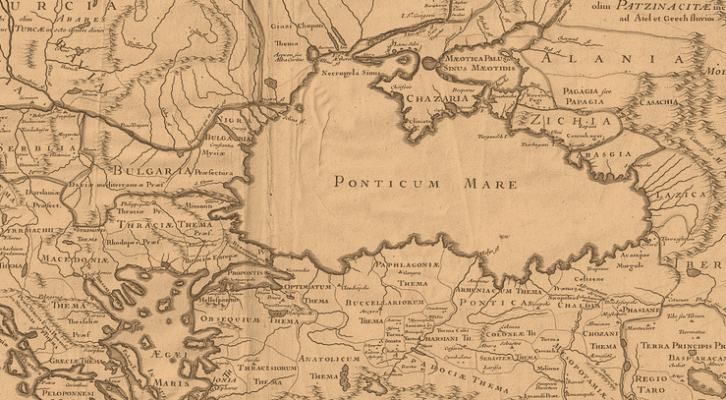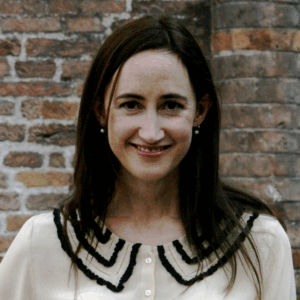
How Language Evolved Out of Cultural Exchange Between Europe and the Near East
Laura Spinney on the Development of Early Human Civilization Across Eurasia
The justly named Golden Sands resort, north of Varna on Bulgaria’s Black Sea coast, boasts warm, shallow waters where children can paddle while their parents look on tranquilly from the beach. The continental shelf is wide here, protruding around fifty kilometers (thirty miles). It is submerged today, but there have been times when the sea level was lower and the shelf was exposed. For most of the past two million years, in fact, the Black Sea was not a sea but a lake, a large fresh or brackish pond cut off from the Sea of Marmara, the Mediterranean and oceans beyond. Periodic warming caused the Mediterranean to rise and spill over the rocky sill of the Bosporus, injecting a mass of salty water into the lake and reconnecting it to the world ocean.
The lake was most recently cut off during the last ice age, when much of the world’s water was locked up in glaciers. The glaciers melted, the oceans rose, and the moment when the Bosporus plug could no longer hold back the Mediterranean came, in one telling, between nine and ten thousand years ago. Water roared over that giant weir with the force of two hundred Niagara Falls, triggering a tsunami that surged through estuaries and lagoons and flooded an area the size of Ireland.
The Black Sea, always a valuable resource in itself, now became a conduit for other resources, including genes, technology and language.
The manner of the reconnection, if not the fact of it, is debated. Some say that it happened gradually, as the Black Sea overflowed into the Caspian Sea, the Caspian Sea regurgitated the excess and the oscillation between them eventually subsided. Others say that the water level in the Black Sea rose ten meters as opposed to sixty. If it “only” rose ten meters, the area of land flooded would have been smaller, the size of Luxembourg rather than Ireland. Still others suggest that, because that prodigious wall of water had to pass through the slender bottleneck of the Bosporus, it would have taken time for the sea levels to equalize. The Bosporus Valley might have roared at full spate for decades rather than months, a wondrous sight and sound in itself.
The two American geoscientists who proposed the deluge theory in 1997, William Ryan and Walter Pitman, speculated that the tales told by traumatized eyewitnesses might have been passed down orally over generations, until eventually they inspired the flood myths of the Bible and the Epic of Gilgamesh. “He who saw the deep” are the first words of Gilgamesh’s poem, written four thousand years ago in Mesopotamia, while Noah witnessed “all the fountains of the great deep broken up.” There’s no way of testing Ryan and Pitman’s theory, as compelling as it is (and flood myths are not unusual). But perhaps the more profound impact of those events on humanity was that the Black Sea, always a valuable resource in itself, now became a conduit for other resources, including genes, technology and language.
By the time it was reconnected, it was roughly the shape and size that it is today. The Greek geographer Hecataeus of Miletus likened it to a Scythian bow, with the southern coast representing the string and the northern one the curved staff. The Greeks called it the “inhospitable sea” (Pontus Axeinus), until they colonized its bountiful shores in the first millennium BCE and renamed it the “hospitable sea” (Pontus Euxinus). It teemed with fish that had been pursued through the Bosporus Valley, now Strait, by dolphins, seals and minke whales. It was probably Turkish mariners who, pursuing the fish, encountered its treacherous squalls and dubbed it “black.”
To the north of the sea lay the steppe, known there as the Pontic steppe in a nod to the Greeks. To the east lay the rugged peaks of the Caucasus, to the south the mountains and high plateaus of the Turkish peninsula or Anatolia, to the west the wooded hills of the Balkans and the Danube flood plain. Each was a world unto itself, but they met at the Black Sea, and whatever was exchanged between them could be ferried back deep into the interior via the great rivers that empty into it: not least the Don, Dnieper, Dniester and Danube. (Hold on to that recurring D, a linguistic tale to which we’ll return.)
Ten thousand years ago, the Balkans were inhabited by the hunter-gatherers who had seen out the ice age in Europe. Another group of hunter-gatherers had moved west from the Caspian Sea as the world warmed, settling around the marshes and lagoons of the northern Black Sea coast and the rivers that feed them. At that time, a stretch of river south of modern Kyiv consisted of a series of rocky cataracts and lakes known as the Dnieper Rapids. Archaeozoologists, people who study animal bones including those retrieved from old rubbish dumps, say there were catfish in those rapids the size of baby whales. The Eastern hunter-gatherers squatted the riverbanks, spears poised over the brooding megafish.
(The catfish of the Dnieper were up to two and a half meters or over eight feet in length, and three hundred kilograms—over six hundred pounds—in weight. Catfish approaching that size still swim in European rivers. They terrorize archaeologists diving for Roman relics in the murky River Rhone, whom they have been known to catch by the flippers, only letting go when they realize that archaeologists are too big to swallow. They are wels catfish, where wels, the common name of the species in German, shares a root with English “whale.”)
To the south of the Black Sea, in the Fertile Crescent, the farming revolution was underway. “Revolution” is a somewhat misleading term, in fact, since the set of practices that we call farming came together over a long period of time, in different places, through trial and error. The hunter-gatherers living at the western edge of the Iranian Plateau, in the Zagros Mountains, were probably the first to domesticate the goat (only the second animal to be domesticated after the dog, whose wolfish origins lie deep in the ice age).
They likely grew wheat and barley too. To the west of them, in Anatolia and the Levant—modern Lebanon, Israel and Jordan—other hunter-gatherers began penning sheep and cultivating chickpeas, peas and lentils. In time the aurochs, a wild ox with long, curved horns, joined the domestic herd. The first farmers would have needed new words to describe these plants and animals, and the tools they invented to harness them. They would have acquired a vocabulary of agriculture.
Farming became a true revolution when its practitioners started expanding out of the Fertile Crescent. Throughout the twentieth century, archaeologists argued over whether the farmers themselves had migrated, or it was just their inventions that had traveled—whether other populations had simply embraced their ideas. Genetics showed that the farmers had moved, and on a massive scale. But theirs was in no way a conscious empire-building project; with each passing generation they simply needed more land to feed the growing number of mouths. It was colonization by leapfrog: an advance guard traveling on foot identified a promising new site up to several hundred kilometers ahead, and others gradually settled the land in between. They took their languages with them.
Farmers from Anatolia entered Europe via two routes. One stream crossed the Bosporus, reaching the eastern Balkans by 6500 BCE and then following the Danube inland. Within a thousand years they were building villages in the Carpathian Basin—the depression, centered on modern Hungary, that is bound by the Carpathian Mountains and the Alps. A second stream island-hopped across the Aegean and along the northern Mediterranean seaboard by raft or boat (rowing, not sailing), then headed north from France’s azure coast. The two streams met in the Paris Basin, the lowlands before the Atlantic, and there they mingled before fanning out again.
By 4500 BCE, descendants of the Anatolian farmers were all over Europe, as far west as Ireland and as far east as Ukraine. These movements took place over many, many generations, but the distances covered are still extraordinary when you think that, apart from the sea crossings, they happened on foot. There was as yet no donkey or other docile pack animal, no horse that wasn’t wild, no wheel and hence no wagon.
As the farmers advanced, the indigenous hunter-gatherers retreated. They were so few, and their footprint in the landscape so light, by comparison, that the immigrants might have had the impression that they were encroaching on virgin territory, at least to begin with. Some of the displaced hunter-gatherers headed for the Baltic Sea; others may have joined those skewering catfish on the Dnieper (who would certainly have spoken a language that was foreign to them). Still others stayed in their ancestral lands but sought refuge in the hills, or in the densest parts of forests: places that didn’t lend themselves to cultivation, meaning the farmers passed on by.
By 4500 BCE, the physical and genetic barriers that had divided Eurasian populations for tens of thousands of years had begun to come down, but a new divide had opened up.
Occasionally, in a forest clearing, a farmer and a hunter-gatherer must have come face to face. The encounter would have been a shock for both. Roughly forty thousand years had passed since their ancestors had parted ways during the exodus from Africa, enough time for them not only to behave and sound different but to look different too. The farmers were smaller, with dark hair and eyes and, probably, lighter skin. The hunter-gatherers had that now rare combination of dark hair and skin and blue eyes. They had no language in common, and they likely had different ideas on just about everything, from child-rearing to death to the spirit lives of animals.
From what archaeologists can tell, such encounters did not typically end in violence. Sometimes the parties exchanged knowledge and objects. Sometimes they interbred. In time, many hunter-gatherers converted to the new economy, ensuring that some of their genes, perhaps even some of their beliefs and words, were passed on. But in general they couldn’t compete. Their way of life and their languages were on a fast track to extinction.
From the Zagros Mountains, the Iranian farmers expanded east across the Iranian Plateau, in the direction of Afghanistan, Pakistan and India, and north towards the Caucasus. Not even the formidable Greater Caucasus range, with its “gloomy, mysterious chasms, into which the mists crept down, billowing and writhing like serpents” deterred them, though they may have hugged the Caspian coast where the mountains tumble to the plain. Soon farming settlements dotted the foothills of the North Caucasus. North of those hills lay the band of wetlands called the Kuma-Manych Depression. This might have held the revolution up for a while, but before long it had penetrated the flatlands we call the steppe. And since you couldn’t grow crops in the steppe—at least not in that part of it, where conditions were often too dry—the steppe-dwellers selected the one component of the farming package that worked for them: herding. The idea might have percolated in from the west as well, from the direction of the Carpathians.
At first the steppe tribes kept only small herds, for the purposes of ritual sacrifice, and they continued to live off hunting and fishing. In time the herds became a source of food and textiles for them too. And as the herds grew, those people were forced to make occasional forays out of their valleys in search of fresh pasture. They strayed into the open steppe, but never far, and they always returned.
By 4500 BCE, the physical and genetic barriers that had divided Eurasian populations for tens of thousands of years had begun to come down, but a new divide had opened up. This one was cultural. It separated herders from farmers, those whose wealth was mobile from those whose wealth was immobile. The two economic models bred two different mindsets: one that prized self-sufficiency and lived for the present, the other that valued collective decision-making and planned for the future.
Both the Bible and the Qur’an recount how this clash of worldviews led to the first murder, that of the shepherd Abel by his farmer brother Cain, but the clash is much older than the Abrahamic scriptures. In the Black Sea region it started more than six thousand years ago, when farmers and herders found themselves cheek by jowl at two steppe boundaries: one in eastern Europe, the other in the North Caucasus. That encounter marked the beginning of a dance of death that, for millennia to come, would bind the two in mutual hostility and dependence. Each grew and attained new heights of sophistication thanks to the other, but any malaise that affected one affected the other too, and climate change periodically rolled the dice. It was against this backdrop that the Indo-European languages were born.
__________________________________

From Proto: How One Ancient Language Went Global by Laura Spinney. Copyright © 2025. Available from Bloomsbury Publishing.
Laura Spinney
Laura Spinney is a science journalist and writer of fiction and nonfiction. She has published two novels in English, and her writing on science has appeared in National Geographic, Nature, the Economist and the Guardian, among others. She is also the author of Proto: How One Ancient Language Went Global (2025), the story of the Indo-European languages.



















